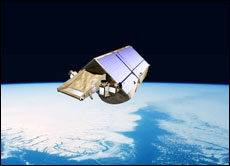CryoSat takes significant step towards final completion

CryoSat satellite design
CryoSat, the first Earth Explorer mission within ESA’s Living Planet Programme, is now entering the final phase of assembly prior to its scheduled launch next year.
CryoSat is designed to measure changes in the Earth’s terrestrial and marine ice fields and aims to provide conclusive evidence as to whether there is a trend towards diminishing polar ice cover as a result of climate change.
The first part of the Critical Design Review (CDR), which was successfully completed on 13 June, confirmed that the flight configuration design is compliant with the key design requirements and can now be integrated and tested. This step marks the beginning of the final phase of assembly of the spacecraft.
The principal purpose of the first part of the CryoSat Space Segment CDR was to review the spacecraft functionality and interfaces amongst each of its sub-systems. A second phase of the CDR will begin at the end of October to check that the final design of the spacecraft and its instrument sub-systems are capable of meeting the stringent system requirements and that the mission meets its primary scientific goals.
Construction of the satellite platform that hosts the SIRAL instrument and other sub-systems has already begun at the prime contractor Astrium GmbH’s test and integration facility in Friedrichshafen, Germany. Prototype models of key sub-systems such as the SIRAL, Central Data Management Unit, Star-trackers and Mass Memory Unit are concurrently undergoing testing. At sub-system level various suppliers around Europe, Russia and the US are contributing to the CryoSat satellite.
In parallel to the Space Segment CDR, the Ground Segment Design Review began on 19 June at ESRIN in Frascati, Italy and has now also been successfully completed. The purpose of this review was to thoroughly assess the completeness and consistency of the current Ground Segment design, together with the suitability of testing and quality control plans.
The completion of these two major milestones paves the way for the launch of CryoSat in late 2004 from Plesetsk in Russia.
Media Contact
More Information:
http://www.esa.intAll latest news from the category: Physics and Astronomy
This area deals with the fundamental laws and building blocks of nature and how they interact, the properties and the behavior of matter, and research into space and time and their structures.
innovations-report provides in-depth reports and articles on subjects such as astrophysics, laser technologies, nuclear, quantum, particle and solid-state physics, nanotechnologies, planetary research and findings (Mars, Venus) and developments related to the Hubble Telescope.
Newest articles

A universal framework for spatial biology
SpatialData is a freely accessible tool to unify and integrate data from different omics technologies accounting for spatial information, which can provide holistic insights into health and disease. Biological processes…

How complex biological processes arise
A $20 million grant from the U.S. National Science Foundation (NSF) will support the establishment and operation of the National Synthesis Center for Emergence in the Molecular and Cellular Sciences (NCEMS) at…

Airborne single-photon lidar system achieves high-resolution 3D imaging
Compact, low-power system opens doors for photon-efficient drone and satellite-based environmental monitoring and mapping. Researchers have developed a compact and lightweight single-photon airborne lidar system that can acquire high-resolution 3D…





















